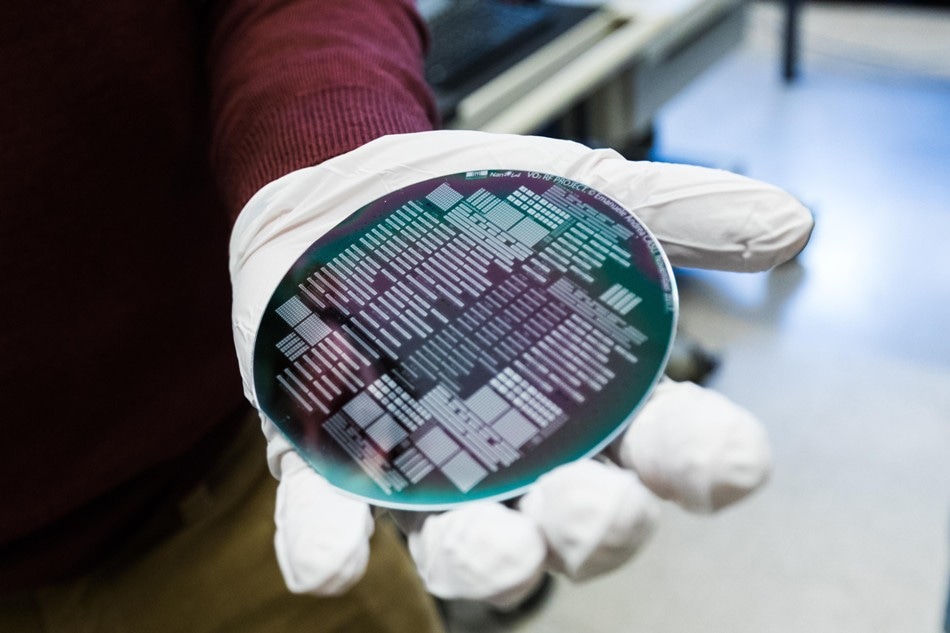Feb 6 2018
The distinctive characteristics of vanadium dioxide (VO2) render it ideal to outperform silicon and opening the door to an innovative class of low-power electronic devices.
Engineers working in the Phase Change Switch project (https://phasechange-switch.org/) — funded by the European Union’s (EU) Horizon 2020 research program and coordinated by EPFL scientists, have demonstrated the way this compound can be adopted to generate programmable radio-frequency electronic functions for aerospace communication systems. Alternative applications of the VO2, such as in artificial intelligence and neuromorphic computing, also look probable.
 CREDIT: Jamani Caillet/EPFL.
CREDIT: Jamani Caillet/EPFL.
First the switch was developed. Subsequently, the transistor was created. At present, another innovation seems to transform the manner in which the electron flow through a circuit is controlled — VO2. An important property of this compound is that at room temperature, it functions like an insulator; however, at temperatures greater than 68 °C, it functions like a conductor. This function, also called metal-insulator transition, has been investigated in a pioneering EU Horizon 2020 project known as Phase-Change Switch. EPFL was selected to coordinate the project subsequent to a difficult selection procedure.
The project will be continued until the year 2020 and has been awarded an EU funding of €3.9 million. Owing to the range of highly prospective applications in which this new technology can be used, the project has drawn two major companies, namely, Thales of France and the Swiss branch of IBM Research, and also other universities, such as Max-Planck-Gesellschaft in Germany and Cambridge University in the United Kingdom. Gesellschaft für Angewandte Mikro- und Optoelektronik (AMO GmbH), an Aachen University spin-off, in Germany, has contributed toward the study.
For many years, researchers have been aware of the electronic characteristics of VO2; however, they could not explain these characteristics to date. It has become apparent that the atomic structure of VO2 gets altered due to increase in temperature, transforming from a crystalline structure at room temperature to a metallic structure at temperatures greater than 68 °C. This transformation occurs within a nanosecond, a real benefit for electronics applications.
VO2 is also sensitive to other factors that could cause it to change phases, such as by injecting electrical power, optically, or by applying a THz radiation pulse.
Adrian Ionescu, Professor, EPFL
Adrian Ionescu leads the Nanoelectronic Devices Laboratory (Nanolab) of the school and also works as the Phase-Change Switch project coordinator.
Reaching higher temperatures
Yet, uncovering the complete abilities of VO2 has hitherto been very challenging since the 68 °C transition temperature is very low for modern electronic devices in which circuits should have the ability to run without defects at temperatures of 100 °C. However, two scientists from EPFL, Ionescu from the School of Engineering (STI) and Andreas Schüler from the School of Architecture, Civil and Environmental Engineering (ENAC), could have discovered a way to overcome this difficulty, as indicated by their joint study reported in Applied Physics Letters in July 2017. They discovered that when germanium was added to VO2 film, the phase change temperature of the material is increased to more than 100 °C.
More intriguing outcomes from the Nanolab, specifically for radio-frequency applications, were reported in IEEE Access on February 2nd, 2018. As a first ever attempt, researchers could develop modulable, ultra-compact frequency filters. Their technology involves using VO2 and phase-change switches, and is specifically efficacious in the frequency range significant for space communication systems — the Ka band, including programmable frequency modulation of 28.2-35 GHz.
Neuromorphic processors and autonomous vehicles
These propitious findings could probably motivate further studies related to applications of VO2 in ultra-low-power electronic devices. Apart from space communications, other areas of use may be high-frequency radars for self-driving cars and neuromorphic computing.